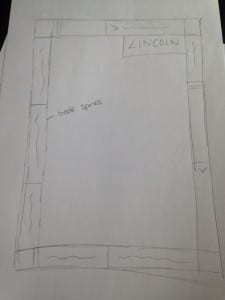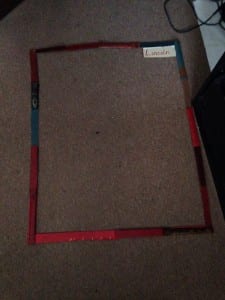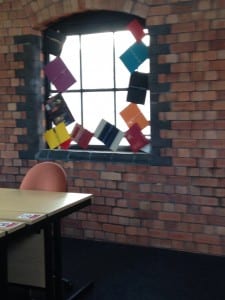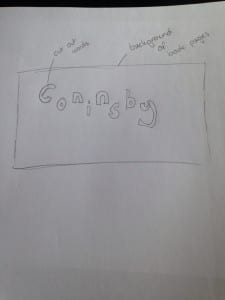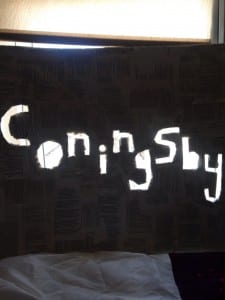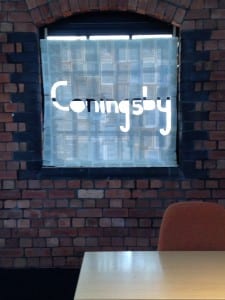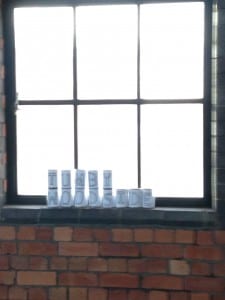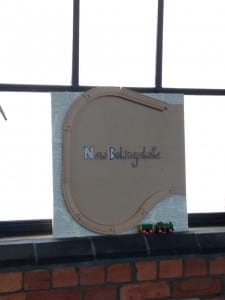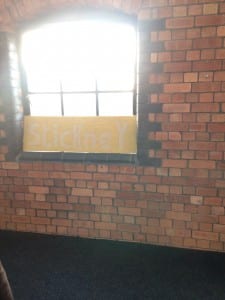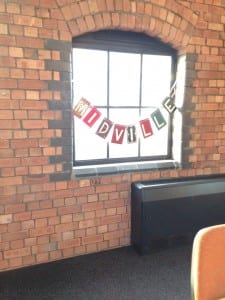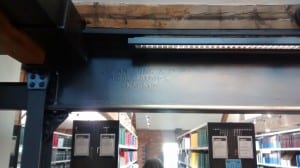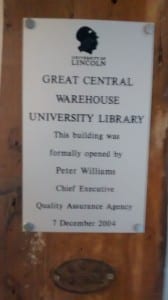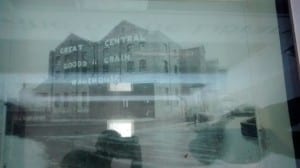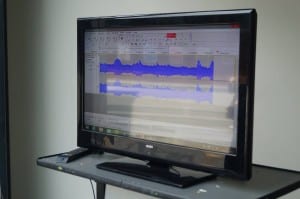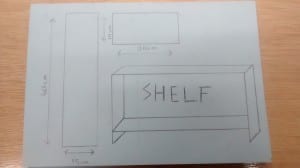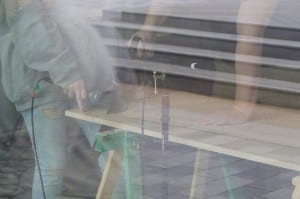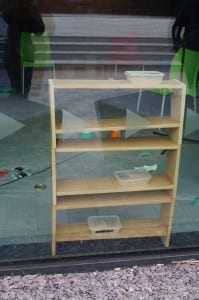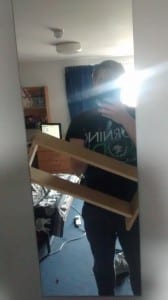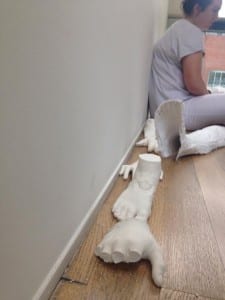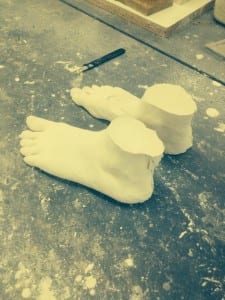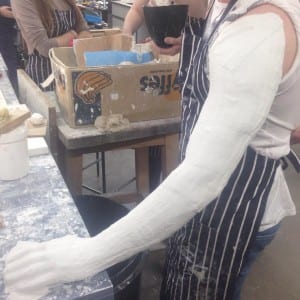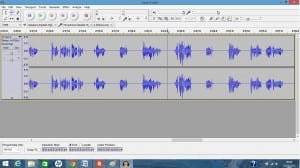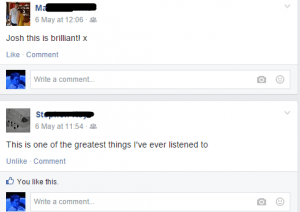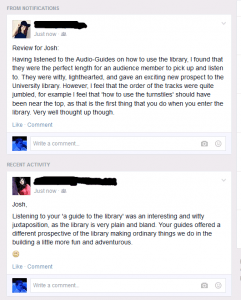Framing Statement
Site Specific is a second year drama module that focuses on creating performance or performative work that is relevant in terms of history or culture to a location that has been previously allocated to each group. The site allocated to me was the University Library, also known as the The Great Central Warehouse/Library. This location used to be a warehouse, alongside a railway, used for transporting goods around Lincolnshire, and this is the idea that I have based my work on. My work is a performative series of creative art pieces to represent each individual station that the goods used to be transported to. These pieces were displayed on the third floor of the University Library on the 7th May for four hours to help encourage students to look into the history of their library and pay attention to architectural features they may have previously ignored.
Research and Process
During my research phase, I found instantly inspiration from an artist called ‘Phlegm’ who creates artwork on buildings in and around Sheffield. He is a street artist, who draws inspiration from the areas around him and their past, present and future issues. The result is often beautiful artwork to symbolise what is happening within these areas. Phlegm offers no explanation for his artwork and remains anonymous. This means his pieces take on a different meaning for each viewer, giving them incentive to think about what his piece is about. His artwork is always preserved, and is a great feature of the city. Here is a piece of artwork Phlegm created in Mosborough, Sheffield. This is believed to have been created as a response to the council and their plans to remove the site this painting has been made on. This piece really changed the way people responded to the site, and so the site was not removed but preserved to keep the artwork upon it. This piece of art changed the views of the council and public perspective, and this is what I would like my piece to achieve.
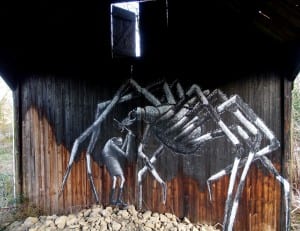
(Phlegm, undated, cited in http://www.phlegmcomicnews.blogspot.co.uk/, undated)
I wanted my piece to also be symbolic of the past, present and future of the University Library, and so I looked for inspiration around in and around the library, starting with the organisation system.
The alphabetical system is a main feature of the library, it creates an easy organisation that students are familiar with. I wanted to look at this concept when I started creating my piece.
I had thought about using the alphabet as a starting point. Having the letters A-Z in board-like forms, each containing a word that relates to the library. Whether this be the library structure or the way the library is used. You could follow the boards, in alphabetical order, on a trail-like adventure through the library, causing you to visit and look at places you may not have been aware of.
Although Conan and Dan liked my idea in the proposal meeting, they did feel as though I could push myself further and push the boundaries I had created for myself. I could have been more ambitious and worked on a bigger scale, been more daring and creative with my work.
They suggested I could have made the boards bigger and more visual, to put them at eye level and make them more appealing by using interesting and different materials. It was suggested that maybe I could look at old warehouse produce and the railway. I needed to emphasise the architectural features more and explore hidden areas of the library, encourage the audience to use and explore the full space.
It was also suggested I don’t use the whole alphabet for my work, and I only focus on a few letters, focus on making them bigger and using different more diverse materials. This gave me more time to make those fewer boards bigger and better, as I would not be focusing on twenty six different boards, but rather a few simpler boards. It was suggested I lead the trail myself and take on a performance role, leading the audience around the library and taking them on the journey.
I took inspiration from Tim Etchell’s letters within Nick Kayes ‘Site Specific Art’ book as he talks about asking members of Sheffield city for their answers to certain question. Except I took a group of my friends from different courses and asked them one question, ‘where have you been within the library?’. Most of my had only been to the floor where their course books were, and a majority of them had never been to the third floor. This would come to be my final location.
I later had a progress meeting with Dan about my ideas and the progression of my piece. My idea had changed to using the third floor as my location, particularly the back wall of the third floor. This was because the third floor is an interesting space in general, as there is an unspoken understanding that you do not speak up there. I could play on this idea of silence and have no sound made within my piece. The audience will be purely focusing on the work I have created. The back wall is made from the original brickwork from when the library was a warehouse, and as my piece was about drawing attention to the unnoticed areas of the library, this would be ideal.
I wanted to build on my idea of an illustrated trail, but make it specific to the third floor. I wanted the brickwork of the back wall to be a feature. One way to do this was to look at the railway, and use a literal railway as the basis of the trail. I thought about having it circulate around the wall of the third floor, leading you to different ‘boards’ and ideas presenting information about the warehouse and its uses. I had the opportunity to use solid materials, like grain, IT equipment, books, brick, and pages to help create these boards and make them a sculptural piece rather than an informational piece. These ‘boards’ could be styled like a railway station to fit in with a railway theme.
My piece progressed to focus on the idea of the railway and the warehouse’s uses. I thought about having a literal railway that would run around the back wall of the library and would carry a small amount of grain. This would be a play on my idea of a trail, as you can follow the railway from board to board. My boards further progressed to being representative pieces based on the old railway stations.
I used ‘The Book as Art’ as part of my inspiration for the pieces that I had created. I liked the diverse images within the book and the different things they represented. I was inspired by this and wanted to create my own representative artwork. Obviously my piece had to be site specific, and with my site being the University Library, I set about researching the Central Warehouse and its uses.
I discovered the train line used to run by the side of the library, and collect goods and grain to take to different areas around Lincolnshire. These areas were Lincoln, Coningsby, Tumby Woodside, New Bolingstoke, Stickney and Midville. This gave me the idea of having six different art pieces to represent each station.
I wanted to use and explore diverse and unusual materials for my piece, this would help my work to stand out against any usual paintings or drawings that could be considered ‘uninteresting’ and fail to capture the attention of passing students.
Each station gives focus to a different aspect connecting the library and the warehouse. This idea has developed from my proposal meeting with Conan and Dan and their suggestions on how to make my work bigger and more ambitious. By having my boards develop into visual art pieces, this made me focus more on the materials I could have used and also work on a bigger scale. The pieces would be at eye level and would capture the attention of library users and bring their attention to the back wall of the library, which is my overall aim.
My Artistic Piece
The first board I created for my piece was the ‘Book Spines Frame’. I wanted to this piece to sit in the first window on the back wall, facing out over Lincoln. This meant the window would encourage the audience to look out over Lincoln, which many people do not do on the third floor of the library. This window showed a beautiful view of Lincoln, over the marina and right up to the cathedral. However, in an initial trial run of my piece, I discovered that this window was not suitable and so I had to move to the right and use a different window. This meant my piece lost its desired effect although it was still looking out over Lincoln, as I had intended. I drew neat sketches for each piece, as a rough idea of how I wanted each piece to look.
Here you can see my rough sketch of the ‘Book Spines Frame’:
I originally wanted my piece to be made entirely out of book spines.
I achieved this and my piece looked almost identical to how I had drawn it. I took this piece to the library to trial this on site. I discovered my piece was too small and looked pathetic in the window. People were ignoring my piece as they walked past, which was not what I wanted. My piece was also flimsy and unable to stand alone. I needed this piece to stand upright alone and be able to support itself. After trying to strengthen my piece and extend it, it became apparent that I needed to rethink my idea and ensure my piece was strong and supportive of its own weight.
I took my piece home where I began to rebuild this idea. I decided that book spines were too weak of a material and were unable to stand without the book backing it. I then decided to use hardback book covers. This material was strong and sturdy, they were also bright and bolder. They stood out and were capable of catching audience attention. The book covers were also able to stand on their own without support, and so I began to re-create my piece using this material.
I used thin pieces of wood build a supportive frame and wood glue to stick the book covers on to this frame. I took this back to the library to trial and the piece was able to stand freely alone within the window and was quickly catching attention. I decided to leave this as one of my final pieces.
I quickly began work on my second piece, the ‘Book Pages Collage’.
Here you can see my original sketch for the piece:
This piece was to be created entirely out of book pages, backed on to corregated cardboard to keep my piece sturdy and still. The word ‘Coninsby’ was cut out of the cardboard, this is so that when the board was mounted against the window, the light will shine through the word and be visually appealing to the audience. This would draw direct attention to the back wall of the library, which was the main focus of my piece. The book pages are used as a direct and visual link to the library, as well as being a material for me to explore and be creative with.
I took this piece to the libary for a trial run. I quickly discovered that although my piece was attracting attention, it was not big enough to cover the whole window and so was losing some of its visual impact. I took this piece home and rebuilt it using a bigger frame made of wood. This covered the whole window and had its desired impact upon the audience members.
I decided not to use my sketches as a basis for my work anymore, as these sketches seemed to be slowing me down. I revisted the library with a few friends late at night and they helped me to accurately measure each window to ensure that I did not have sizing problems again.
This is my third piece for ‘Tumby Woodside’
This piece is made out of cans to represent the industrial side of the warehouse. I wanted this piece to mainly speak for itself and have the audience question the use of cans. I wanted this piece to be minimal as the main focus is about the cans and the industrial side of the warehouse. The minimal effect of this piece is also to represent when the warehouse was abandoned for a while after its usage for the transportation of goods, this is why there is only a few cans standing, to help indicate that they have been left behind during the period of absence.
Here is my piece for ‘New Bolingstoke’:
I wanted to use the materials I had sourced for my piece. I had originally intended my wooden train track to run infront of the windows, however after discussing with the Library Staff they made me aware that this would be a potential tripping hazard and it would not be practical to set this up. I then spoke to them about having a grain trail to create a train track, instead of a wooden rail and they emphasised this again would not be practical due to cleaning up the mess on the silent floor. I instead used my wooden train track to create and art piece to represent ‘New Bolingstoke’. This is a literal representation of the train track and fits as a substitute for my original idea.
I wanted the railway to be emphasised, although it did not work out how I had planned. I feel this piece shows the railway in a literal sense and brings to light the idea of the railway and it’s uses.
Here is my piece for ‘Stickney’:
This piece is made entirely out of grain. The grain sticks to the back of the board, having the word ‘Stickney’ the only part that is not covered in grain. The grain is to represent the agricultural side of the library warehouse and how the railway used to carry grain and goods around the county.
Here is my piece for ‘Midville’:
The book backs are a direct link to the literal library as we know it now. They also end the ‘journey’ as they are made out of the same material as the first piece, the Book Frame. This is a kind of framing for the piece, having the piece start and end with book backs.
Evaluation
I did find there to be a lot of flaws with my project and the site I was using. The first problem I encountered with my site was the journey to the library. I had to create all my pieces at home as it could not be done on site, this was because making my pieces on site would be impractical due to the rules of my location. Making my project would mean making extensive noise and I would need a lot of room to set it up. Noise was my main issue as the third floor is a silent floor and having space is unachievable on the third floor of the library during dissertation time.
I had to bring my piece ready-made to the library, this meant I would need to travel 6 art pieces across Lincoln from my house, this proved a difficult task on my own. I opted for a taxi instead, and asked originally for a minibus to take my pieces safely across to the library. The taxi company could not offer me a minibus at that time of day and instead offered me an estate car. I told the taxi company about my project and gave them the exact size of my biggest piece (48 inches by 48 inches). They assured me an estate car was big enough to fit my project and so I booked the taxi for 5.30am.
I had no problem moving my project from my house to the taxi. I did however, have a problem when getting my project into the taxi. After being assured multiple times that I did not need a minibus and an estate car would be big enough for my pieces, I then discovered that the piece in fact would not fit in an estate car. This meant I had to break part of my project to transport it to the library.
After getting my pieces to the third floor and setting them up without a struggle, I sat down to keep watch over my pieces until they were being assessed. Around 7.30am, the cleaners came to clean the area. I do not think the cleaners had been informed of my project as one of them tried to move my ‘Coningsby’ board. She was little and could not reach the top, so she pulled the board from middle, resulting in the material being ripped slightly and the wood frame becoming twisted. After spending a few hours trying to fix my piece with tape, I discovered it was unfixable and the only way to perfect this was to redo the piece. However, it took me three days to make the piece in the first place and I did not have the time or resources to re-create my board. This means my board would not stand in the window and would have to be placed below the window.
My audience varied throughout the day, as at the start of the day there was barely anyone there but during the afternoon a lot of people came to view my piece and took time out of their studies to look and interact with my piece. I could not gage any particular reaction to my piece as we were on the silent floor, but a number of students left my piece to bring their friends up to also look at my pieces, which could either be taken as positive or negative.
My final performance worked well as it attracted some social media attention throughout its duration. I feel my piece achieved its aim of drawing focus to the ignored areas of the library and also led audience members to think about the old warehouse and its former uses.
I feel I could have improved my performance by adding in a descriptive piece of text to thoroughly explain the concept of my piece, as this was not immediately obvious. Although the absence of this could have either helped my performance by encouraging the audience to look deeper into my piece, or also have hindered my performance by causing the audience confusion or misunderstanding. If I could perform my piece again, I would defiantly look at adding this feature in. I would have also started building and editing my pieces much earlier in the process to allow myself much more time to change and adapt my piece as problems, such as sizing, occurred. This would save me time and mean I had longer to perfect each of my pieces. My engagement with site specific theory and practice has advanced my understanding of performance in a non-traditional venue by encouraging me to look further into the history and features of locations to better understand their value. This could also help inspire my performances for future projects.
Word Count: 3293
Bibliography
Kaye, N (2000) Site Specific Art: Performance, Place and Documentation. Routledge: London.
University Of West England (2014) Book Arts [Online] Bristol: University. Available from: http://www.bookarts.uwe.ac.uk/ [Accessed 14th February 2015]
Phlegm (2014) Phlegm Art [Online] Available from: http://www.phlegmcomicnews.blogspot.co.uk/ [Accessed 14th February 2015]
